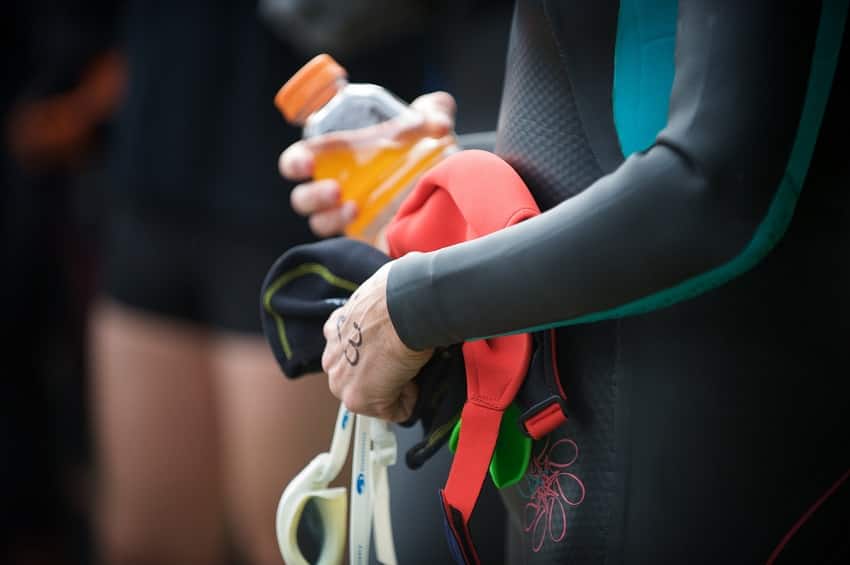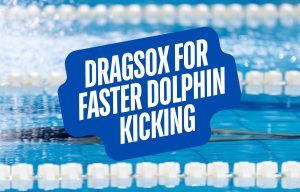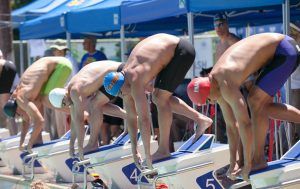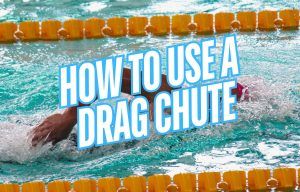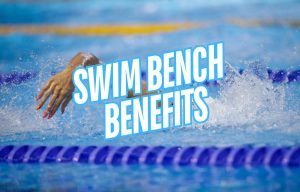Ready to start open water swimming? Here is the essential equipment you’ll need to swim safely and comfortably.
For the swimmer used to crushing laps on the regular in a pool, you likely already have some of the super basic things you will need to swim out into your local lake, ocean or river.
Swimmers already have a basic swim-suit, a set of swimming goggles, and a trusty swim cap.
But open water swimming is a different beast.
While the swimming and the strokes you use are basically the same, the challenges posed by the environment are different. (Not as many head-up breaststrokers meandering down the middle of the lane, for starters.)
In this guide for beginners, we look at some essential open water swim gear for improved performance and safety while wild swimming.
Let’s dive right in.
Essential Open Water Swim Gear for Safety and Comfort
Here is a quick look at the essentials for open-water swimming:
- Open water swim goggles
- Swim cap
- Wet suit
- Swim buoy
- Sunblock
- Swim watch
- Neoprene swim socks
- Thermal swim gloves
Next, we’ll take a closer look at each and highlight some of our favorite brands and products so that you can hit the open waters with confidence.
Open water swim goggles
While pool goggles generally do the trick, even in open water swimming, there are specialized swim goggles designed to meet the unique challenges posed by swimming outdoors.
Swim goggles for open water feature a wider gasket and lens, which increase peripheral vision and allow you to see more easily and get your bearings.
Open-water swim goggles also have polarized and mirrored lenses, eliminating glare and eye strain from the sun’s UV rays.
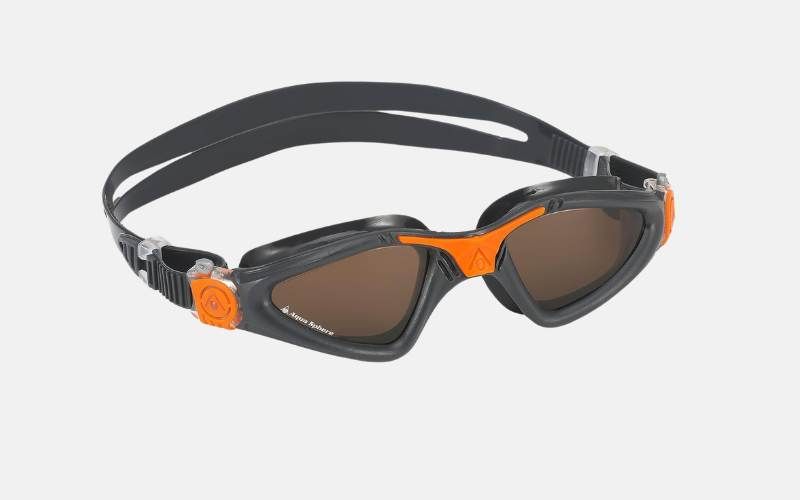
Another key difference between pool and open-water goggles is the strap buckle positioning. On pool goggles, head straps tend to be adjusted at the back of the head, while on open-water swim goggles, the head strap is configured at the sides of the gasket.
This makes it more convenient to change or adjust goggle tightness while swimming quickly.
Finally, open water swimming goggles tend to be bulkier than pool goggles, allowing for increased peripheral vision and wider lenses.
The best goggles for open-water swimming include the Aqua Sphere Kayenne and Arena Cobra Tri Swipes.
If you are looking for something extra comfortable, TheMagic5 Goggles are a hybrid pool and open water swim goggle that eliminate leaks and increase comfort with a customized goggle gasket made specifically for your face.
Swim cap
For warmer or lukewarm bodies of water, you can typically stick with your regular latex or silicone swim cap to keep hair out of your face and be visible in the water.
But for chilly ocean swims, a neoprene swim cap will help insulate your head and keep you warm. The increased neoprene thickness retains body heat for increased comfort in cold water.
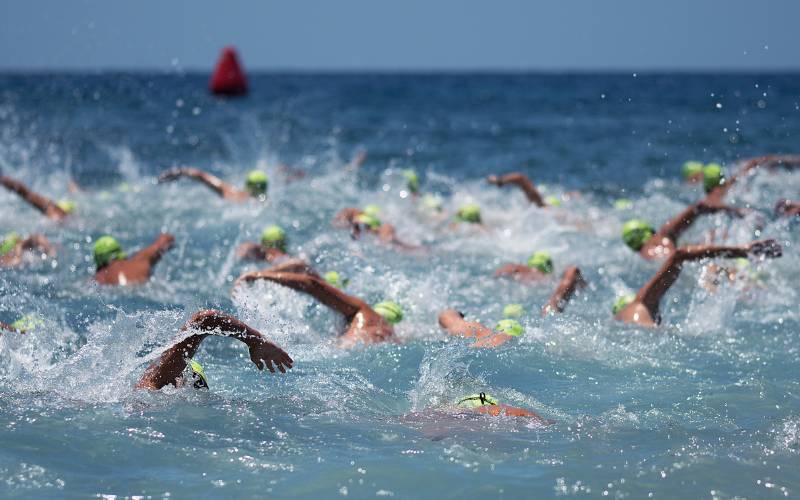
Whether swimming in cold or slightly cold water, wear a bright swim cap so that you are visible to others out on the water, whether that’s other swimmers or boats.
Wet suit
While wet suits generally aren’t cheap, the natural buoyancy, sun protection, and warmth they provide may be worth the investment.
Swimmers will note that they can swim more efficiently with a wetsuit thanks to the added floatation from neoprene, a type of rubber that doesn’t absorb water and retains body heat.
Naturally, wetsuit fit is crucial here—ensure that your fancy new wet suit is snug and sits correctly on your body.
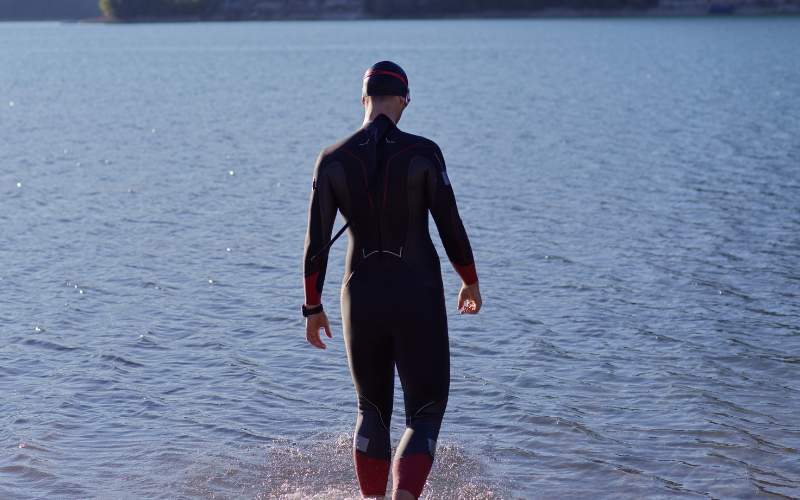
Too small, and it chokes your arm and shoulder rotation; too big and loose, and you’ll be pouring water into the suit, causing crazy amounts of drag. For racing, there are a variety of suits you can use, including swim skins.
Wetsuits have a ton of fancy features, including high-vis markings for extra visibility and safety on open water, zipper closures to make it easy to close up the suit, soft collars to prevent chafing on the neck, and much more.
Choosing the perfect wetsuit for swimming in open water ultimately comes down to comfort and features. Look for a open water wetsuit with appropriate thickness, zipper and lanyard, and safety features like high-vis markings to stay safe when swimming.
If possible, head down to your local multi-sport shop and try on some different wetsuits. Look for brands like TYR, Roka, blueseventy, Orca, and Synergy.
Open water swimming buoy
Speaking of safety and bright stuff, you should always have a tow buoy behind you when swimming solo.
Open water swim buoys are small inflatables that attach to your waist and skip lightly across the surface of the water behind you.
Swim buoys are designed with super bright, high visibility colors (highlighter yellow, for instance), are super light (you barely notice it behind you), and help boaters, lifeguards, and other swimmers keep sight of you.
Swim buoys are also useful storage tools. Keys and smartphones can be placed inside the floating buoy, so you won’t have to worry about leaving them on shore.
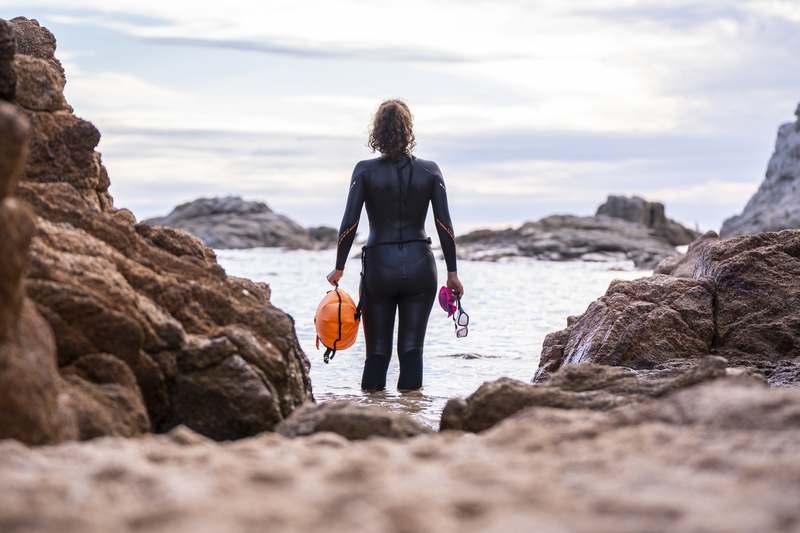
For swimmers who want maximum accuracy when tracking open water swims, placing your multi-sport watch or GPS device in the buoy ensures a constant GPS connection for more detailed swim mapping.
Ultimately, swim buoys are a safety device that open water swimmers should always use on solo swims.
I’ve found that many newer open-water swimmers like the little boost in confidence they get from having the buoy with them. You can use the buoy to catch your breath in case of cramping or a quick break.
Sunblock
Safety in open water comes in many forms, and one of the elements swimmers must contend with is the sun and its UV rays. Longer outdoor swims require protection.
Waterproof sunscreens can do the job for “shorter” swims of 60-90 minutes–depending on the time of day, obviously–but for true sun blocking, opt for zinc oxide.
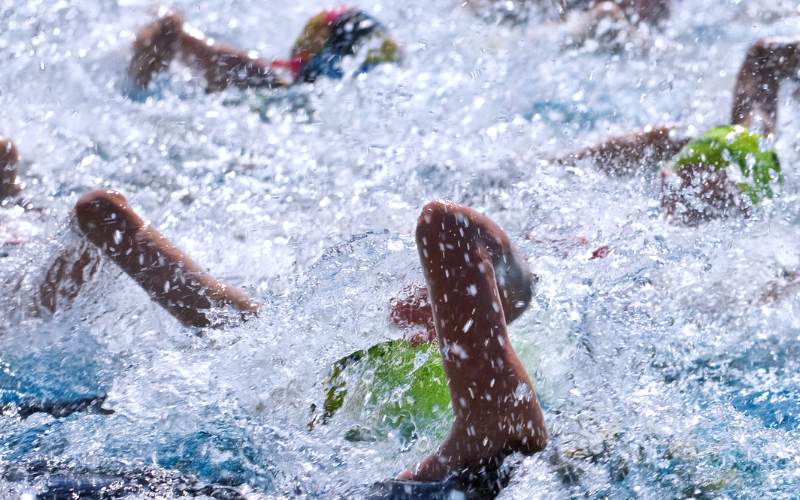
Sunscreens filter the sun’s rays while zinc oxide almost completely blocks them out. Zinc oxide is remarkably resilient and lasts for hours.
Zinc oxide will make your skin look chalky white but is a physical block to the harmful rays (compared to the chemical block that sunscreens provide).
Swim watch
A swim watch is a tool that can provide reams of data for open water swimmers, from GPS tracking to DPS (distance per stroke) to time and distance elapsed. Swim watches give you a ton of feedback that allows beginners to gauge progress and track their open-water swims.
An experience every open water swimmer goes through during the early days is seeing just how jagged the path they are swimming truly is. Seeing the post-swim map of how straight (or not) you swam can help you learn to stay on course when swimming.
More advanced swim watches also include weather data like water temperature, tides, wind speeds, and other environmental factors to help you better prepare for a successful open-water swim.
The top multi-sport watches on the market are made by Garmin, with the Forerunner, Vivoactive, Fenix, and Garmin Swim 2 being excellent options for tracking open-water swims. The Apple Watch and the multitude of third-party swim apps that it supports also have excellent trackability features.
Note: Swimmers who want to see real-time data of their open water swims while swimming can do so with the FORM Swim Goggles. The goggles display swim workout metrics from your swim watch in the lens on a heads-up display so that you can follow along with the data that matters most to your swim.
Neoprene swim socks
Neoprene swim socks are another cold water accessory to help your feet retain heat in open water. Like neoprene swim socks and made of the same material as a wetsuit, neoprene swim socks reduce heat loss from your extremities.
These swim socks can be tucked into the bottom of your wetsuit, come in varying thicknesses, and often have gripped bottoms to help your feet maintain traction when walking along slippery surfaces like wet rocks.
Although they appear constrictive, swim socks are flexible and allow for a full range of motion when kicking and swimming.
Thermal swim gloves
Thermal swim gloves are also made of neoprene and are designed to keep your hands warm and prevent water from seeping into your wet suit during cold water swimming.
They typically feature extra long cuffs tucked into the arms of your wet suit and 1.5-2mm of neoprene thickness to retain heat and keep you comfortable while swimming.
Thermal swim gloves, unlike swim paddles, provide a generous amount of flexibility for proper hand placement while swimming. Some thermal swim gloves, such as those made by Synergy, have webbing for added pulling power and bright colors to increase visibility.
Wrapping Things Up
Open water swimming is very different from pool swimming in several vital respects, most notably regarding safety. Out on the open water, there are no walls or lane ropes to hang onto when you get tired or lifeguards to pull you in when you cramp up.
Choosing swim gear that promotes safety, from bright caps and swim buoys to a wetsuit that increases floatation, can make your open water swims more enjoyable and, most importantly, safer.
Choose the right swim gear for the weather and water conditions, plot out your swim, and get the most from swimming in open water.

